Jens Kober
STEP: Structured Training and Evaluation Platform for benchmarking trajectory prediction models
Sep 18, 2025Abstract:While trajectory prediction plays a critical role in enabling safe and effective path-planning in automated vehicles, standardized practices for evaluating such models remain underdeveloped. Recent efforts have aimed to unify dataset formats and model interfaces for easier comparisons, yet existing frameworks often fall short in supporting heterogeneous traffic scenarios, joint prediction models, or user documentation. In this work, we introduce STEP -- a new benchmarking framework that addresses these limitations by providing a unified interface for multiple datasets, enforcing consistent training and evaluation conditions, and supporting a wide range of prediction models. We demonstrate the capabilities of STEP in a number of experiments which reveal 1) the limitations of widely-used testing procedures, 2) the importance of joint modeling of agents for better predictions of interactions, and 3) the vulnerability of current state-of-the-art models against both distribution shifts and targeted attacks by adversarial agents. With STEP, we aim to shift the focus from the ``leaderboard'' approach to deeper insights about model behavior and generalization in complex multi-agent settings.
Impedance Primitive-augmented Hierarchical Reinforcement Learning for Sequential Tasks
Aug 27, 2025Abstract:This paper presents an Impedance Primitive-augmented hierarchical reinforcement learning framework for efficient robotic manipulation in sequential contact tasks. We leverage this hierarchical structure to sequentially execute behavior primitives with variable stiffness control capabilities for contact tasks. Our proposed approach relies on three key components: an action space enabling variable stiffness control, an adaptive stiffness controller for dynamic stiffness adjustments during primitive execution, and affordance coupling for efficient exploration while encouraging compliance. Through comprehensive training and evaluation, our framework learns efficient stiffness control capabilities and demonstrates improvements in learning efficiency, compositionality in primitive selection, and success rates compared to the state-of-the-art. The training environments include block lifting, door opening, object pushing, and surface cleaning. Real world evaluations further confirm the framework's sim2real capability. This work lays the foundation for more adaptive and versatile robotic manipulation systems, with potential applications in more complex contact-based tasks.
ASkDAgger: Active Skill-level Data Aggregation for Interactive Imitation Learning
Aug 07, 2025Abstract:Human teaching effort is a significant bottleneck for the broader applicability of interactive imitation learning. To reduce the number of required queries, existing methods employ active learning to query the human teacher only in uncertain, risky, or novel situations. However, during these queries, the novice's planned actions are not utilized despite containing valuable information, such as the novice's capabilities, as well as corresponding uncertainty levels. To this end, we allow the novice to say: "I plan to do this, but I am uncertain." We introduce the Active Skill-level Data Aggregation (ASkDAgger) framework, which leverages teacher feedback on the novice plan in three key ways: (1) S-Aware Gating (SAG): Adjusts the gating threshold to track sensitivity, specificity, or a minimum success rate; (2) Foresight Interactive Experience Replay (FIER), which recasts valid and relabeled novice action plans into demonstrations; and (3) Prioritized Interactive Experience Replay (PIER), which prioritizes replay based on uncertainty, novice success, and demonstration age. Together, these components balance query frequency with failure incidence, reduce the number of required demonstration annotations, improve generalization, and speed up adaptation to changing domains. We validate the effectiveness of ASkDAgger through language-conditioned manipulation tasks in both simulation and real-world environments. Code, data, and videos are available at https://askdagger.github.io.
Versatile, Robust, and Explosive Locomotion with Rigid and Articulated Compliant Quadrupeds
Apr 17, 2025Abstract:Achieving versatile and explosive motion with robustness against dynamic uncertainties is a challenging task. Introducing parallel compliance in quadrupedal design is deemed to enhance locomotion performance, which, however, makes the control task even harder. This work aims to address this challenge by proposing a general template model and establishing an efficient motion planning and control pipeline. To start, we propose a reduced-order template model-the dual-legged actuated spring-loaded inverted pendulum with trunk rotation-which explicitly models parallel compliance by decoupling spring effects from active motor actuation. With this template model, versatile acrobatic motions, such as pronking, froggy jumping, and hop-turn, are generated by a dual-layer trajectory optimization, where the singularity-free body rotation representation is taken into consideration. Integrated with a linear singularity-free tracking controller, enhanced quadrupedal locomotion is achieved. Comparisons with the existing template model reveal the improved accuracy and generalization of our model. Hardware experiments with a rigid quadruped and a newly designed compliant quadruped demonstrate that i) the template model enables generating versatile dynamic motion; ii) parallel elasticity enhances explosive motion. For example, the maximal pronking distance, hop-turn yaw angle, and froggy jumping distance increase at least by 25%, 15% and 25%, respectively; iii) parallel elasticity improves the robustness against dynamic uncertainties, including modelling errors and external disturbances. For example, the allowable support surface height variation increases by 100% for robust froggy jumping.
Explosive Jumping with Rigid and Articulated Soft Quadrupeds via Example Guided Reinforcement Learning
Mar 20, 2025Abstract:Achieving controlled jumping behaviour for a quadruped robot is a challenging task, especially when introducing passive compliance in mechanical design. This study addresses this challenge via imitation-based deep reinforcement learning with a progressive training process. To start, we learn the jumping skill by mimicking a coarse jumping example generated by model-based trajectory optimization. Subsequently, we generalize the learned policy to broader situations, including various distances in both forward and lateral directions, and then pursue robust jumping in unknown ground unevenness. In addition, without tuning the reward much, we learn the jumping policy for a quadruped with parallel elasticity. Results show that using the proposed method, i) the robot learns versatile jumps by learning only from a single demonstration, ii) the robot with parallel compliance reduces the landing error by 11.1%, saves energy cost by 15.2% and reduces the peak torque by 15.8%, compared to the rigid robot without parallel elasticity, iii) the robot can perform jumps of variable distances with robustness against ground unevenness (maximal 4cm height perturbations) using only proprioceptive perception.
MUKCa: Accurate and Affordable Cobot Calibration Without External Measurement Devices
Mar 16, 2025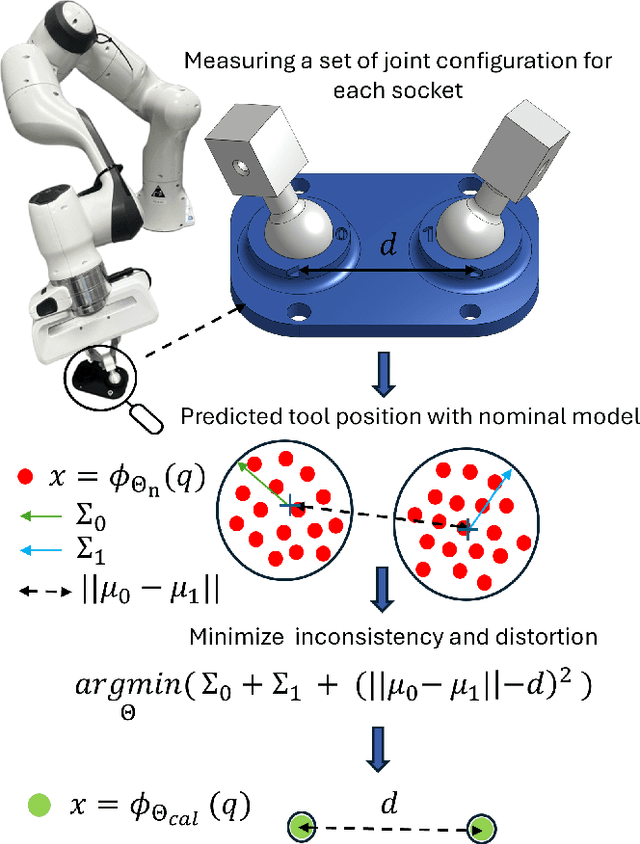
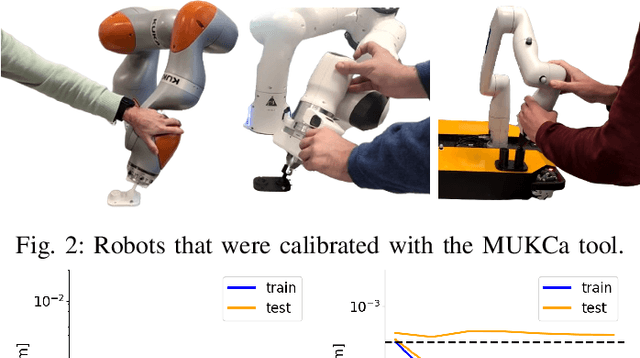
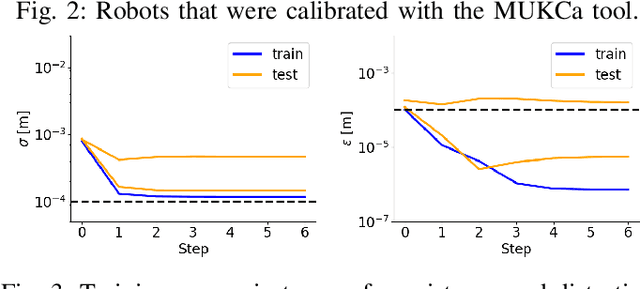
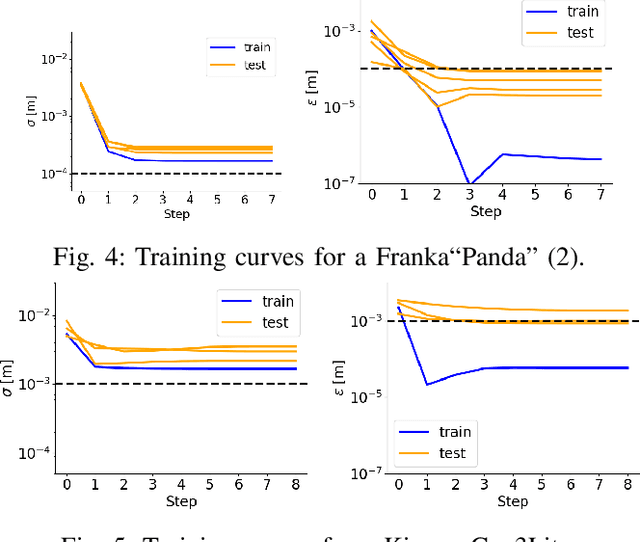
Abstract:To increase the reliability of collaborative robots in performing daily tasks, we require them to be accurate and not only repeatable. However, having a calibrated kinematics model is regrettably a luxury, as available calibration tools are usually more expensive than the robots themselves. With this work, we aim to contribute to the democratization of cobots calibration by providing an inexpensive yet highly effective alternative to existing tools. The proposed minimalist calibration routine relies on a 3D-printable tool as the only physical aid to the calibration process. This two-socket spherical-joint tool kinematically constrains the robot at the end effector while collecting the training set. An optimization routine updates the nominal model to ensure a consistent prediction for each socket and the undistorted mean distance between them. We validated the algorithm on three robotic platforms: Franka, Kuka, and Kinova Cobots. The calibrated models reduce the mean absolute error from the order of 10 mm to 0.2 mm for both Franka and Kuka robots. We provide two additional experimental campaigns with the Franka Robot to render the improvements more tangible. First, we implement Cartesian control with and without the calibrated model and use it to perform a standard peg-in-the-hole task with a tolerance of 0.4 mm between the peg and the hole. Second, we perform a repeated drawing task combining Cartesian control with learning from demonstration. Both tasks consistently failed when the model was not calibrated, while they consistently succeeded after calibration.
Beyond Behavior Cloning: Robustness through Interactive Imitation and Contrastive Learning
Feb 11, 2025Abstract:Behavior cloning (BC) traditionally relies on demonstration data, assuming the demonstrated actions are optimal. This can lead to overfitting under noisy data, particularly when expressive models are used (e.g., the energy-based model in Implicit BC). To address this, we extend behavior cloning into an iterative process of optimal action estimation within the Interactive Imitation Learning framework. Specifically, we introduce Contrastive policy Learning from Interactive Corrections (CLIC). CLIC leverages human corrections to estimate a set of desired actions and optimizes the policy to select actions from this set. We provide theoretical guarantees for the convergence of the desired action set to optimal actions in both single and multiple optimal action cases. Extensive simulation and real-robot experiments validate CLIC's advantages over existing state-of-the-art methods, including stable training of energy-based models, robustness to feedback noise, and adaptability to diverse feedback types beyond demonstrations. Our code will be publicly available soon.
Noise-conditioned Energy-based Annealed Rewards (NEAR): A Generative Framework for Imitation Learning from Observation
Jan 24, 2025



Abstract:This paper introduces a new imitation learning framework based on energy-based generative models capable of learning complex, physics-dependent, robot motion policies through state-only expert motion trajectories. Our algorithm, called Noise-conditioned Energy-based Annealed Rewards (NEAR), constructs several perturbed versions of the expert's motion data distribution and learns smooth, and well-defined representations of the data distribution's energy function using denoising score matching. We propose to use these learnt energy functions as reward functions to learn imitation policies via reinforcement learning. We also present a strategy to gradually switch between the learnt energy functions, ensuring that the learnt rewards are always well-defined in the manifold of policy-generated samples. We evaluate our algorithm on complex humanoid tasks such as locomotion and martial arts and compare it with state-only adversarial imitation learning algorithms like Adversarial Motion Priors (AMP). Our framework sidesteps the optimisation challenges of adversarial imitation learning techniques and produces results comparable to AMP in several quantitative metrics across multiple imitation settings.
Mastering Contact-rich Tasks by Combining Soft and Rigid Robotics with Imitation Learning
Oct 10, 2024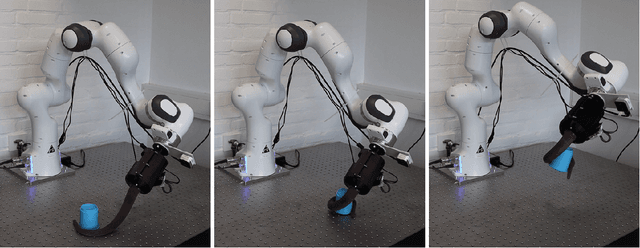
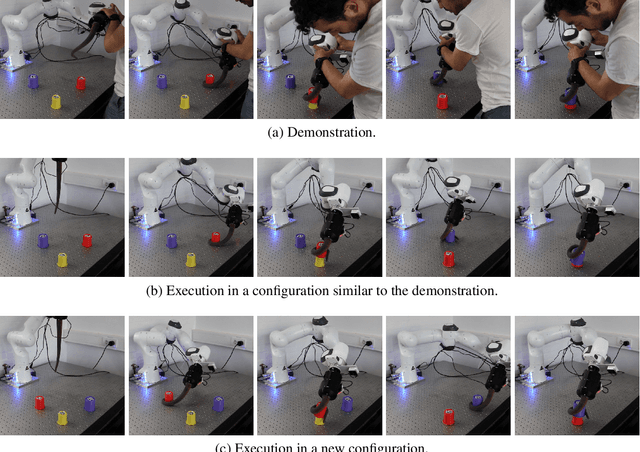
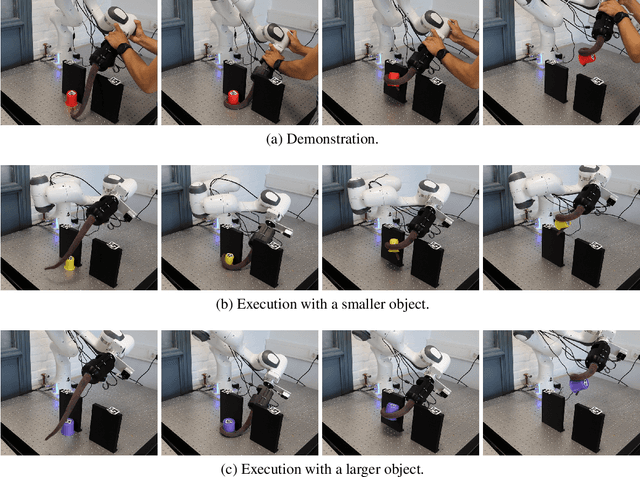

Abstract:Soft robots have the potential to revolutionize the use of robotic systems with their capability of establishing safe, robust, and adaptable interactions with their environment, but their precise control remains challenging. In contrast, traditional rigid robots offer high accuracy and repeatability but lack the flexibility of soft robots. We argue that combining these characteristics in a hybrid robotic platform can significantly enhance overall capabilities. This work presents a novel hybrid robotic platform that integrates a rigid manipulator with a fully developed soft arm. This system is equipped with the intelligence necessary to perform flexible and generalizable tasks through imitation learning autonomously. The physical softness and machine learning enable our platform to achieve highly generalizable skills, while the rigid components ensure precision and repeatability.
Task-unaware Lifelong Robot Learning with Retrieval-based Weighted Local Adaptation
Oct 03, 2024



Abstract:Real-world environments require robots to continuously acquire new skills while retaining previously learned abilities, all without the need for clearly defined task boundaries. Storing all past data to prevent forgetting is impractical due to storage and privacy concerns. To address this, we propose a method that efficiently restores a robot's proficiency in previously learned tasks over its lifespan. Using an Episodic Memory (EM), our approach enables experience replay during training and retrieval during testing for local fine-tuning, allowing rapid adaptation to previously encountered problems without explicit task identifiers. Additionally, we introduce a selective weighting mechanism that emphasizes the most challenging segments of retrieved demonstrations, focusing local adaptation where it is most needed. This framework offers a scalable solution for lifelong learning in dynamic, task-unaware environments, combining retrieval-based adaptation with selective weighting to enhance robot performance in open-ended scenarios.
 Add to Chrome
Add to Chrome Add to Firefox
Add to Firefox Add to Edge
Add to Edge